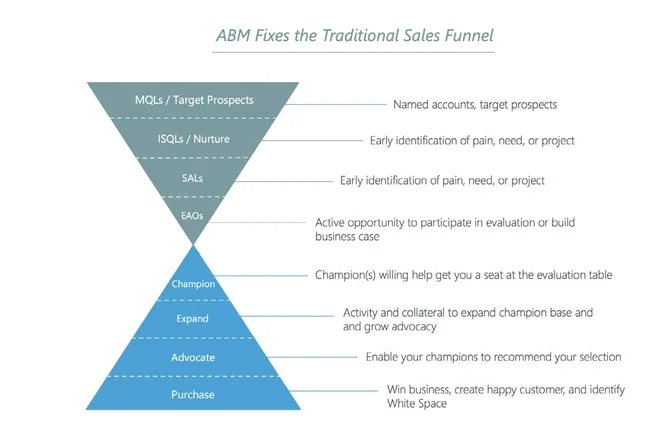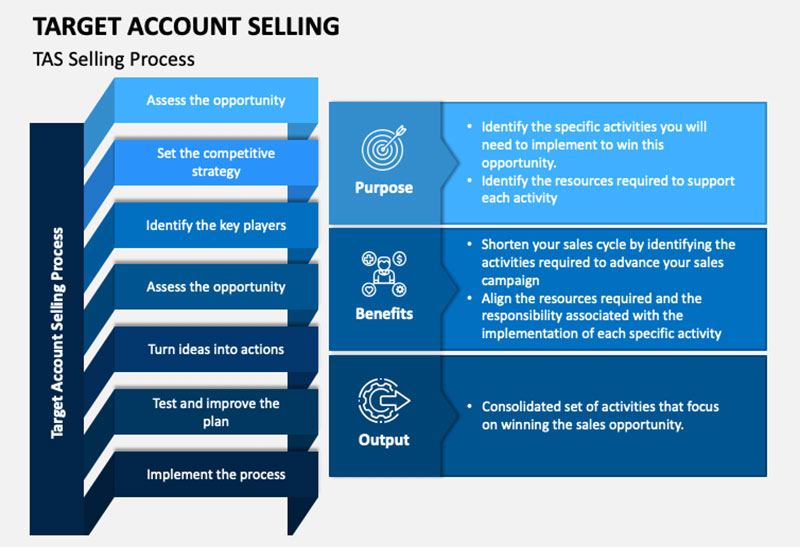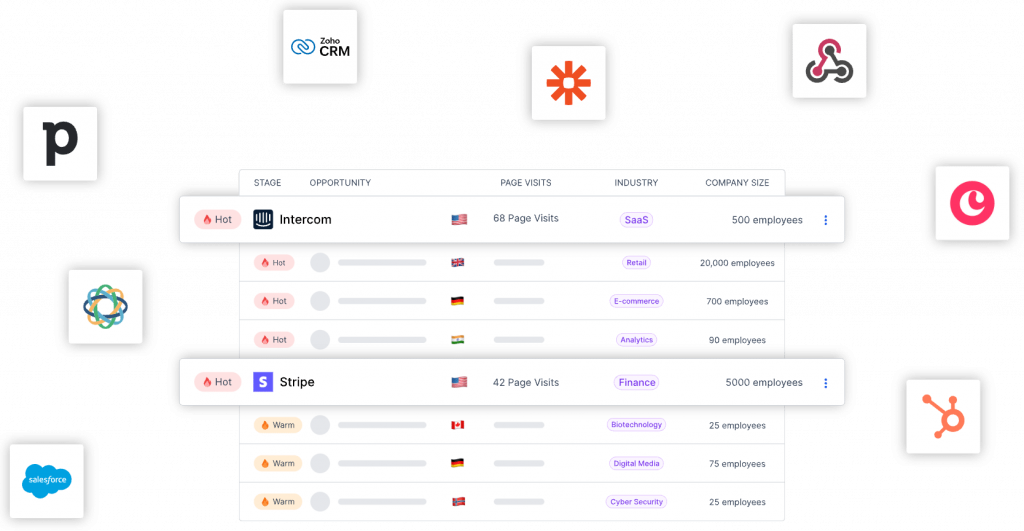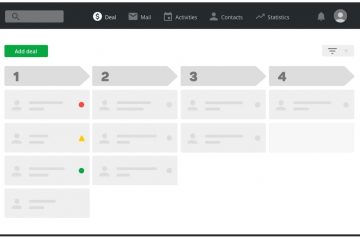What is Target Account Selling (TAS)? Is It Different From Account Targeting and ABM?
When it comes to B2B sales, there are many strategies you can implement to achieve your target results. However, for B2B businesses selling high tickets, some tactics work better than others—and today, we will discuss one of those higher revenue-generating methodologies. We are talking about Target Account Selling (TAS) and ABM (which is also referred to as Account Targeting).
Target Account Selling is a B2B sales strategy that centers on identifying and pursuing high-value customer accounts with the highest potential for generating revenue. Instead of sweeping across the board with a spray-and-pray approach, this methodology puts an emphasis on individualized and personalized engagement with specific businesses or organizations that match your ideal client persona (ICP). Account Targeting, as a marketing framework, plays a crucial role in Target Account Selling.
Through comprehensive research and comprehension of the distinct pain points and needs of the targeted accounts, your sales teams may create customized communications that are both highly relevant and persuasive, hence raising the probability of conversion success. In today’s highly competitive business environment, account targeting is a particularly effective tactic for cultivating lasting customer relationships, ensuring high-value conversion opportunities, optimizing revenue, and achieving sustainable business growth.
In this blog, we will discuss what account targeting means, the different types of TAS, its benefits and challenges, when you should use it, and what are the key elements involved in account targeting. Let’s get started!

Image Source: Hubspot
What is Account Targeting?
Account targeting, or account-based marketing (ABM), is a direct marketing tactic, especially prevalent in the B2B market, that involves targeting certain high-value client accounts, who are ideally a perfect match for your ideal customer persona (ICP), and nurturing long-standing relationships with them for seamless conversion and long-term retention. It frequently works best when combined with other marketing techniques, such as direct mail and targeted advertising.
In the case of account targeting, high-value ideal prospects receive information and updates about products that are specifically designed to meet their needs, as well as engaging content, news, and updates that are largely unrelated to sales. In the long term, the emphasis switches to maintaining the relationship through announcements, news, and product updates while also keeping an eye out for fresh approaches to provide key client accounts with value propositions that help in retention.
There are many different types of account targeting strategies you can implement based on the specific goals, requirements, and strengths of your business. These include:
- Industry-based Targeting: This focuses on targeting accounts in the same sectors, assuming that the prospects may face the same industry-specific problems.
- Size-based Targeting: This involves targeting accounts of the same size, such as small and medium-sized enterprises (SMEs) or large corporations. This depends more on your capabilities and the resources you have available at your disposal.
- Geographic Targeting: This focuses on pursuing accounts within a specific geographical location or region. This is particularly relevant for companies with a localization agenda.
- Customer Segment-based Targeting: This involves pursuing specific customer accounts based on customer profiles, demographics, or other such characteristics. For example, targeting accounts seeking a specific feature that your product or service offers.
- Strategic Targeting: This focuses on targeting key strategic accounts that have the potential to impact the overall business significantly. These accounts are generally high-value, have great revenue-generating potential, and are therefore, crucial for achieving long-term success.
Now that you have a concise understanding of what account targeting or target account selling involves, let’s understand its challenges and benefits in the next two sections.
Challenges of Account Targeting
While a very effective sales strategy, account targeting or TAS comes with its own set of challenges. Let’s check them out.
Identifying the Right Accounts
There is no surefire method to decide which accounts should be targeted; instead, it depends on the judgment of the marketers or salespeople. This implies that mistakes could be made, particularly if the professionals lack experience in account targeting. Thorough research and analysis are necessary to determine which accounts to target, and failure to do so can seriously hinder success.
Allocating Resources Based on Market Changes
Markets are dynamic, and shifts in the economy, laws, or industry trends may have an effect on the feasibility and relevance of targeted accounts. Unless the salespeople are adaptive and have their finger on the pulse of the market, allocating resources to pursue the proper accounts may become difficult. It can be harmful to invest excessive time and energy on unqualified accounts, leading to missed opportunities with accounts that could be beneficial.
Getting Personalization Right
Since account targeting involves a lot of one-on-one communication, it can present a problem when you are trying to scale these efforts. It takes a lot of time and work to craft messages that are unique and suited for every targeted account. Thus, it can be difficult to find the ideal ratio between scalability and customization.
Complexities in the Buying Process
If you are targeting a large organization, chances are you will be met with complex decision-making frameworks involving multiple stakeholders. It can be difficult to navigate and influence these various buying committees; doing so requires a sophisticated awareness of each member’s roles and interests. This again involves thorough research and comprehension of the whole customer account as well as the sales process.
Measuring ROI of Account Targeting Efforts
It might be difficult to calculate the Return On Investment (ROI) for account targeting initiatives. The strategy’s effectiveness cannot be determined with certainty. This might be a big problem since it can be hard to defend investing money in account targeting if it doesn’t work. Robust analytics and tracking tools are necessary to identify the actions that lead to the greatest success and to adjust tactics accordingly.
Benefits of Account Targeting
Here are the top benefits of engaging in account targeting or target account selling.
Increased Website Traffic and Lead Generation
Account targeting allows you to set your business apart from the competition. You may differentiate yourself from your rivals by developing a unique selling proposition (USP) that speaks directly to your account base. Moreover, you will be targeting your ideal prospects with messaging based on the same principle. This will ultimately influence potential customers to select you above your competitors. The result? You will achieve increased website traffic and net more high-value leads with the intent to buy from you.
Improved Conversion Rates and Higher Revenue
Implementing a targeted approach like TAS can enable sales teams to increase the likelihood of successful sales conversions through customized messaging and solutions that meet the unique demands of each account. Salespeople can, thereby, secure larger transactions and create better revenue opportunities by focusing their efforts on high-potential prospects, as opposed to taking a more distributed strategy.
Greater Customer Retention
Focusing on certain accounts can lead sales teams to establish more meaningful and profound connections with important decision-makers in high-value accounts. This can result in increased cooperation and confidence, which in turn, will form lasting customer partnerships, thereby contributing to an increase in customer retention. You have a better chance of keeping your target accounts as clients if you precisely craft your marketing efforts for them.
Shorter Sales Cycle Due To Competitive Advantage
Businesses can set themselves apart from rivals by customizing solutions to match the unique needs of targeted accounts. This competitive edge increases deal success. This may influence a quicker sales cycle. Key decision-makers in your target accounts can quickly and efficiently make decisions about purchasing from you, when they see that you have done your homework and set yourself ahead of the curve from the beginning by having a thorough understanding of their problems and requirements.
Cross-Selling and Upselling Opportunities
Once you get your customers to keep coming back to you, it can become much easier to sell them adjunct products and services. Developing trusting connections with targeted accounts creates the possibility of upselling and cross-selling. Sales teams are easily able to propose more products or services when they have a thorough understanding of the account’s wider demands. This further elevates your potential revenue from a single account.
What is Target Account Selling (TAS)?
Target account selling (TAS) is a B2B sales strategy that identifies prospects based on specific factors such as deal value, ideal customer persona, industry, revenue, pain points, buying signals, and budget. The focus is more on personalized sales resources for these highly qualified leads. It’s about picking the right prospects, researching them, and crafting messages that directly address their pain points. This allows for a hyper-personalized sales approach.
While ABM and TAS are similar approaches in theory, the outcomes they bring to the table can be different. While ABM requires the marketing team to use all available data to identify suitable contacts within an organization to create connections with, TAS requires the salespeople to use the same data to identify the right people to contact about sales. While ABM necessitates that your account manager meticulously arrange campaigns according to the target prospect’s business, representative, past performance, and other factors, TAS also includes creating sales campaign tactics using comparable data.
How does it differ from Account Targeting? While Account Targeting primarily focuses on the marketing part of identifying and targeting accounts, Target Account Selling is a broader sales approach that goes from targeting high-value accounts to closing and retaining them.
In TAS, the sales and marketing teams collaborate to guide each decision-maker, who is a part of the B2B account, through their own buying process, frequently using information from the customer care department until the sale is finally closed. It is a combination of ongoing effort between all three teams, with the customer success team, perhaps, playing the most important role of all—they can offer valuable insights into the customer experience that can be leveraged to improve buyer profiles, prospecting approaches, content, and other strategies for future success.
Target account selling (TAS) can be carried out in two ways—through market research and customer profiling.

Image Source: Eserto
When is the Right Time To Implement Account Targeting and Target Account Selling?
The methodology of target account selling works best when closing big sales deals with a complex buying process involving several decision-makers.
Let’s face it. Target account selling requires a lot of extensive research and cross-departmental cooperation (between marketing, sales, and even customer success teams). You need to devote a lot more time and energy to lead generation, prospecting, and audience research early on in the sales process. However, if done right, the results from TAS can massively pay off later on by improving the effectiveness and efficiency of the entire process for the decision-makers involved.
Furthermore, the effectiveness of this approach depends on your ability to identify potential clients who are seeking a long-term collaboration. Hours of study, planning, and customized TAS campaigns can seem insignificant if the result is a few high-value client who remain loyal to your business for an extended period of time. So, when should you implement account targeting as a sales strategy for your business?
In addition to making sure that TAS aligns with your entire sales strategy and company model, you need to see if you have the following in your support:
- Well-Defined Sales Goals and a Robust Action Plan: To begin implementing the TAS sales strategy for your business, it is essential to set clear sales goals. What goals do you have for TAS? Are you attempting to shorten a protracted sales cycle? Draw in new clients? Offer more to current clients? It is critical to resolve this as soon as possible because your objectives will guide your entire strategy. Once you get your goals out of the way, you need to create a robust action plan (more on this in the next section).
- Access to Accurate Data: The foundation of any account-based sales approach is data and information. The first step is to invest in a centralized CRM that links every department in your company and combines with all important data sources. You must consider information from social media feeds, conversational insights, website and interaction analytics, customer feedback, market and competition intelligence, sales, marketing, and financial data, among other sources.
- Alignment Between Marketing and Sales: Target account selling is a data-driven partnership involving marketing, sales, and customer success teams. Compared to traditional approaches where each representative handles their own sale, the stakes are substantially higher when numerous persons handle the same deal. Since all of your eggs are in one basket, losing out on a chance, no matter whose fault it is, could have a significant negative impact on your overall revenue. An aligned TAS initiative can potentially multiply the revenue potential of your sales efforts manifold.
The factors highlighted above may do a lot to support your target account selling strategy. However, there are some key elements that guide the TAS methodology. We will be discussing those below.
Guide To Enable Target Account Selling
While TAS is a research-driven strategy, it does not follow a pre-determined set of steps. With that being said, here are some of the common key elements that can guide you to enable target account selling as part of your sales strategy in your business:
Ideal Customer Profile
An ideal customer profile (ICP) is a detailed proforma that includes firmographic, behavioral, and environmental characteristics that are frequently present in your best-performing accounts. Through the examination of data from important accounts and recent achievements, companies can identify the traits that characterize decision-makers in their target market.
A few examples of these variables include industry, business size, location, years in operation, income, budget, client base size, and funding status.
The rationale here is that prospects that display these crucial characteristics are more likely to share traits with the highest revenue-generating customers, offering a focused and well-thought-out framework for acquiring new customers. If you understand these attributes and why they matter, you can prioritize the opportunities that have greater value and choose which triggers to pull to move deals through the pipeline more effectively.
Buyer Personas
TAS generally involves connecting with multiple points of contact within a prospect account. It is one of the many reasons that make it a more successful sales strategy, as compared to gap selling or value selling.
When interacting with different decision-makers in a single account, salespeople can take a varied approach, using different messaging and sales techniques that are suited to each person’s role, interests, and obstacles. Creating thorough buyer personas for every client account inside the targeted ideal accounts becomes crucial, going beyond the ideal customer profile (ICP).
Buyer personas include specifics like job titles, duties, demographics, personality qualities, and preferred communication methods. Since the goal of persona building is to enable the smooth generation of personalised messages and content for each individual decision-maker within the purview of your target accounts, accuracy is crucial. By leveraging this factor, the value of the proposed solution is made clear in a way that best meets the individual needs and viewpoints of each stakeholder in the target account.
Target Account List
A target account list is the the list of accounts your team will target using data-driven prospecting, nurturing, and closing strategies. The initial stage of putting your TAS plan into practice is defining this list. Every account in your list ought to fit well with the products or services you provide and match the qualities you’ve listed in the ICP.
While everyone’s technique will be unique, the following are some suggestions on how you could go about creating your list:
- Use Your ICP to Guide Your Search: You can make use of the qualities listed in your ICP to find possible applicants. For instance, you can look for fresh leads that fit the size and industry of your target client by using LinkedIn’s filters. You can also find accounts based on financing status or income using tools like Owler or Crunchbase.
- Focus on Customer Feedback: You can gain valuable insights into each persona’s viewpoint by utilizing conversational insights and feedback from your top accounts. To inform your initial outreach approach, you can use those insights with the account-specific data you have just gathered. Future discussions can include personal details as you get to know each decision-maker.
- Determine High-Intent Buyers Using Intent Data: Using real-time intent data, you may pinpoint buyers who are prepared to make a purchase based on particular signals (such as visiting a particular page, scheduling a demo, downloading a white paper, etc.). Intent data, as opposed to historical or firmographic data, can assist you in ensuring that you are focusing on the appropriate accounts at the appropriate times.
In conclusion, you should use a variety of data sources to fully comprehend the demands, preferences, and activities of your customers.
Personalized Communications
Account Targeting involves personalized communications that target each account in a relevant and time-sensitive manner. Sales teams should have an abundance of information, templates, and sales strategies at their disposal by the time they reach this point, which will enable them to quickly create customized offers, responses, and messages for each decision-maker involved in the deal they are working on.
This factor places more of an emphasis on long-term campaigns and ongoing engagement than more conventional sales strategies, which typically concentrate on velocity and volume (i.e., number of leads generated, deals closed, demonstrations scheduled, etc.). Cross-functional teams can collaboratively create a plan that specifies the stakeholders to be targeted, the activities to be concentrated on, and the duration of the effort. In addition, based on sales targets and the channels, plays, and technologies required to carry out the game plan, they will decide which metrics to monitor.
When implemented properly, Account Targeting initiatives ought to produce a lot of engagement. Initially, you can assess the effectiveness of your plan by contrasting the results of your present campaign with the engagement metrics you had before Account Targeting. You can delve further into certain touchpoints further as you gather additional data to ascertain which communications and content performed best. The process should become simpler with time. Using customer feedback, sales and marketing data, and the other analytics and business intelligence tools at your disposal, you may further optimize the process by creating tailored templates and sequences.
Identify Target Accounts Visiting Your Website—with Salespanel!
Before we close this article, we want to take a few minutes to introduce you to Salespanel and tell you about how it can assist your TAS strategies.
Salespanel is a visitor intelligence and a data-driven marketing software that helps sales and marketing teams get a grip of all their visitors, leads, and customers and understand each interaction while leveraging data to nurture and close deals. With industry-leading match rates, you can identify and qualify target accounts accounts as soon as they land on your website even before they sign up. This can reveal previously hidden opportunities and help you ace your sales and growth strategies.
Salespanel de-anonymizes B2B accounts in your funnel with great precision and populates your pipeline with target accounts. It also tracks the entire journey of your target accounts, identifying crucial buying intent data points. This can help you better understand the efficacy of your account targeting campaigns and identify high-value prospect accounts as soon as they enter your funnel. The software also identifies the lead source and marketing attributes that drove their purchase. It then uses intelligent tracking, which can function without cookies, to trace the entire customer journey in real-time between devices and domains!
Besides this, Salespanel scores and segments your leads, fast-tracks high account value deals to your sales reps while personalizing their user experience, and syncs lead intelligence to your CRM, whether you are using Salesforce or Pipedrive, or any other popular customer relationship management platform. Furthermore, Salespanel also records real-time buyer intent data ready to power your personalization and customer engagement efforts. In short, you can leverage Salespanel to power your account targeting or target account selling initiatives and achieve sustainable business growth in the long run.

Final Thoughts
Account targeting or target account selling (TAS) is one of the most effective sales strategies for B2B businesses, and we hope we have been able to give you a fair understanding of how it comes together.
While scalability may be a challenge for this methodology, there are a lot of tools in today’s market that can help you automate parts of the TAS process, making it easier for you to ensure sustainable business growth. One of these tools in your tech stack should be a visitor identification and website intelligence software, and if you are looking for one, we would like to recommend Salespanel. Check out our software with a 14-day free trial today!
Key Contributors: Madhurima Chatterjee, Nilangan Ray
Sell more, understand your customers’ journey for free!
Sales and Marketing teams spend millions of dollars to bring visitors to your website. But do you track your customer’s journey? Do you know who buys and why?
Around 8% of your website traffic will sign up on your lead forms. What happens to the other 92% of your traffic? Can you identify your visiting accounts? Can you engage and retarget your qualified visitors even if they are not identified?



